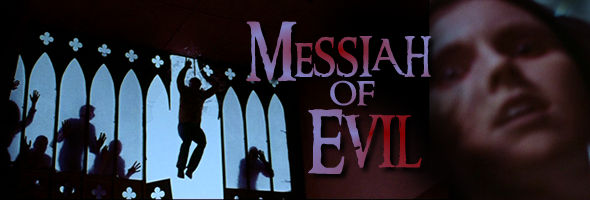
Color, 1973, 91m.
Directed by Willard Huyck
Starring Michael Greer, Marianna Hill, Joy Bang, Anitra Ford, Royal Dano, Elisha Cook Jr., Bennie Robinson
Code Red (Blu-ray & DVD) (US R0 HD/NTSC) / WS (2.35:1) (16:9)

Color, 1973, 91m.
Directed by Willard Huyck
Starring Michael Greer, Marianna Hill, Joy Bang, Anitra Ford, Royal Dano, Elisha Cook Jr., Bennie Robinson
Code Red (Blu-ray & DVD) (US R0 HD/NTSC) / WS (2.35:1) (16:9)
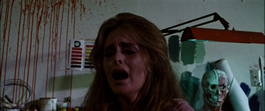 In the desolate seaside town of Point Dune, terrible things are happening to the locals. One unlucky resident (young, future director Walter Hill) gets
In the desolate seaside town of Point Dune, terrible things are happening to the locals. One unlucky resident (young, future director Walter Hill) gets 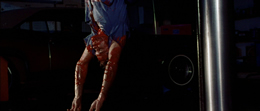 his throat cut in the pre-credits sequence, and the newest visitor, Artleey (Hill), is trying to find out why her missing father wrote a string of increasingly terrifying letters about impending doom. A trip to a gas station on the way leads her to a creepy albino (Robinson) and an ill-fated attendant, while the town itself is filled with dead-eyed residents who weep blood and spend their nights on the shore watching the red-tinged moon rise over the water. A local bohemian named Thom (Greer) and his two female companions (Ford and Bang) fill her in on some of the peculiar local folklore which requires all bodies to be burned upon death, and soon the horrific truth of the town and the malevolent "dark stranger" who cursed it a century before begin to come to light.
his throat cut in the pre-credits sequence, and the newest visitor, Artleey (Hill), is trying to find out why her missing father wrote a string of increasingly terrifying letters about impending doom. A trip to a gas station on the way leads her to a creepy albino (Robinson) and an ill-fated attendant, while the town itself is filled with dead-eyed residents who weep blood and spend their nights on the shore watching the red-tinged moon rise over the water. A local bohemian named Thom (Greer) and his two female companions (Ford and Bang) fill her in on some of the peculiar local folklore which requires all bodies to be burned upon death, and soon the horrific truth of the town and the malevolent "dark stranger" who cursed it a century before begin to come to light. 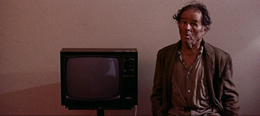 details abound to reward returning viewers. The experimental music score is also a major plus with discordant synthesizer droning weaving through the nighttime scenes and greatly enhancing the overall feeling of unease. Indirect references to the Manson family, the Donner party, and the still-new modern zombie genre also combine to give it a distinct flavor shared only by some of its immediate companion releases like Let's Scare Jessica to Death and Lemora, though a handful of subsequent films like Dead & Buried and Strange Behaviour managed to capture some of the same peculiar magic. It's certainly a film you'll never forget and well worth discovering, preferably late at night with a big bowl of popcorn.
details abound to reward returning viewers. The experimental music score is also a major plus with discordant synthesizer droning weaving through the nighttime scenes and greatly enhancing the overall feeling of unease. Indirect references to the Manson family, the Donner party, and the still-new modern zombie genre also combine to give it a distinct flavor shared only by some of its immediate companion releases like Let's Scare Jessica to Death and Lemora, though a handful of subsequent films like Dead & Buried and Strange Behaviour managed to capture some of the same peculiar magic. It's certainly a film you'll never forget and well worth discovering, preferably late at night with a big bowl of popcorn.
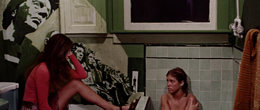 Unfortunately most of Messiah of Evil's attributes were completely smothered throughout much of the home video age thanks to godawful, unwatchable transfers that made mincemeat of the powerful Techniscope compositions and gorgeous, vivid color schemes which betray the obvious influence of Hammer Films and Mario Bava. Anyone who's suffered through any of the public domain cheapie releases might wonder what on earth was going on half the time, while every carefully composed shot was turned into a murky mess. Code Red's officially sanctioned DVD release in 2009 marked the first appearance ever on video of the properly framed version of the film, and to say the least, it was both a major revelation and one of the clearest examples of how radically a good video transfer can change a film's reputation. Some unavoidable debris is still evident from time to time, but this is such a tremendous leap forward in presentation that any quibbling is swept aside by the powerful experience of simply watching this gem in its first acceptable release. Colors look terrific, with eye-popping reds and blues saturating many scenes and the wild artwork found in the daring set design can finally be appreciated.
Unfortunately most of Messiah of Evil's attributes were completely smothered throughout much of the home video age thanks to godawful, unwatchable transfers that made mincemeat of the powerful Techniscope compositions and gorgeous, vivid color schemes which betray the obvious influence of Hammer Films and Mario Bava. Anyone who's suffered through any of the public domain cheapie releases might wonder what on earth was going on half the time, while every carefully composed shot was turned into a murky mess. Code Red's officially sanctioned DVD release in 2009 marked the first appearance ever on video of the properly framed version of the film, and to say the least, it was both a major revelation and one of the clearest examples of how radically a good video transfer can change a film's reputation. Some unavoidable debris is still evident from time to time, but this is such a tremendous leap forward in presentation that any quibbling is swept aside by the powerful experience of simply watching this gem in its first acceptable release. Colors look terrific, with eye-popping reds and blues saturating many scenes and the wild artwork found in the daring set design can finally be appreciated.
 The transfer alone easily placed this among the top essential '70s horror releases, but the deal was sweetened with a host of terrific extras. Huyck and Katz contribute a very informative commentary track moderated by Lee Christian in which they discuss the influence of Polanski and Lovecraft, the segue working from Graffiti to this film, the reasons for shooting in scope, their relative ignorance of George Romero, Huyck's early work at AIP, the unwelcome pop song foisted on the film by distributors (which is dropped here in favor of the original director's cut), and the circumstances which prevented the shooting of some crucial footage which would have shed more light on the dark stranger's identity and Hill's ultimate fate. They return for the 22-minute featurette, "Remembering Messiah of Evil," along with associate editors Morgan Fisher and Billy Weber and cinematographer Stephen Katz, which covers the making of the film from a more general perspective with a focus on finding the actors and the shooting conditions. Other extras include a phone interview with Joy Bang (who got one of the best scenes in the film), two of the team's early B&W short films (the split-screen "The Bride Stripped Bare," a good companion piece to early De Palma films, and "Down These Mean Streets"), a hidden bonus audio interview for Easter Egg hunters, and the usual reel of Code Red trailers for The Statue, Brute Corps, Choke Canyon, Night of the Dribbler, Rituals, Stunt Rock and Family Honor.
The transfer alone easily placed this among the top essential '70s horror releases, but the deal was sweetened with a host of terrific extras. Huyck and Katz contribute a very informative commentary track moderated by Lee Christian in which they discuss the influence of Polanski and Lovecraft, the segue working from Graffiti to this film, the reasons for shooting in scope, their relative ignorance of George Romero, Huyck's early work at AIP, the unwelcome pop song foisted on the film by distributors (which is dropped here in favor of the original director's cut), and the circumstances which prevented the shooting of some crucial footage which would have shed more light on the dark stranger's identity and Hill's ultimate fate. They return for the 22-minute featurette, "Remembering Messiah of Evil," along with associate editors Morgan Fisher and Billy Weber and cinematographer Stephen Katz, which covers the making of the film from a more general perspective with a focus on finding the actors and the shooting conditions. Other extras include a phone interview with Joy Bang (who got one of the best scenes in the film), two of the team's early B&W short films (the split-screen "The Bride Stripped Bare," a good companion piece to early De Palma films, and "Down These Mean Streets"), a hidden bonus audio interview for Easter Egg hunters, and the usual reel of Code Red trailers for The Statue, Brute Corps, Choke Canyon, Night of the Dribbler, Rituals, Stunt Rock and Family Honor.
![]()